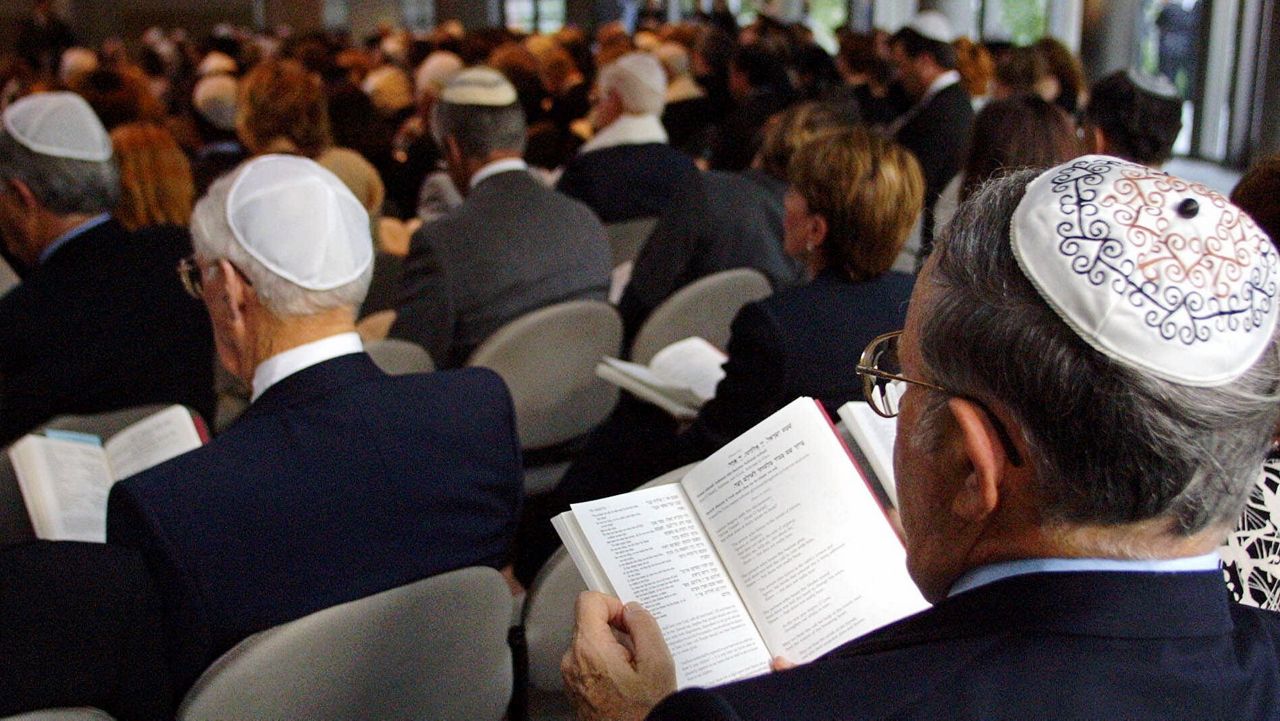CINCINNATI — As police search for the person who threw a Molotov cocktail at a New Jersey synagogue over the weekend, it was a painful reminder of personal battles with antisemitism for Dr. Miriamne Krummel.
The University of Dayton professor recalled a “very disturbing and troubling event” in 2002 where she said one of her students stood up in the middle of class and started screaming, “You killed our God” – an allusion to the idea that Jews crucified Jesus Christ.
Krummel said three years later, while showing a well-known image from the Middle Ages where the biblical figure of Cain is depicted with horns as God kicked him out of Eden, two of her students commented that “Jews still have horns.”
“I was very pregnant with my first child at the time, and I simply leaned over and I said, ‘Mine are retractable,’” she added.
The class was silent and remained that way for the rest of the semester, she said.
“We made it through the rest of the semester, but the incident was particularly unfortunate because it was a lively class until that point,” she said.
The most recent incident at Temple Ner Tamid in New Jersey caused no damage to the house of worship, according to a statement from the Bloomfield Township Division of Public Safety. But media accounts said the incident has left the local Jewish community on edge.
Acts of antisemitism have been around for centuries, said Krummel, who specializes in Medieval literature. In her 2002 book, “The Medieval Postcolonial Jew, In and Out of Time,” she looks at how cultural clashes led to the ostracizing of Jewish people in England and the area that is now Germany.
“We didn’t have Molotov cocktails in the Middle Ages, but the same sort of things were expressed — the burning down of things, the violence, the representations of Jews as beasts or devils,” she said.
In 2021, Anti-Defamation League Center on Extremism noted 2,717 antisemitic incidents throughout the United States. This was a 34% increase from 2020 and the highest number on record since ADL began tracking antisemitic incidents in 1979.
Dr. Matthew Kraus, who heads the Department of Judaic Studies at the University of Cincinnati, said antisemitism, like other forms of extremism and racism, always persists in some capacity but believes the public expression of hate has jumped in recent years.
“This is a direct result of an increasing culture of permissiveness for extremist and antisemitic hatefulness,” Kraus said. “This permissiveness is then coupled with a social media landscape that amplifies these voices.”
United Nations Secretary-General Antonio Guterres made similar comments on Jan. 27 as part of Holocaust Remembrance Day.
During his speech before the U.N. General Assembly in New York, Guterres issued an “urgent” call to combat online hate speech, particularly antisemitism. He cited examples, such as assaults on Orthodox Jews in Manhattan, Jewish children being bullied in Melbourne, Australia, and swastikas spray-painted on the Holocaust memorial in Berlin.
“Neo-Nazi, white supremacist movements are becoming more dangerous by the day,” Guterres said.
Expressions of antisemitism vary, according to Paul Morrow, a visiting assistant professor at the University of Dayton Human Rights Center.
He said some reflect centuries-old tropes about Jewish people being subhuman. Others suggest Jews wield too much power in business or politics, Morrow said.
“International organizations and national governments have had a hard time understanding how social media allows for conspiracy theories and antisemitic tropes to spread so quickly. It’s been quite difficult for them to disrupt these processes,” Morrow said.
Current tensions in Israel may also play a role.
The ADL reported a surge of antisemitic incidents in May 2021 that coincided with a military conflict between Israel and Hamas. For the entire month, 387 antisemitic incidents were tabulated by ADL, 297 of which occurred between May 10 — the official start of military action — and the end of the month, an increase of 141% over the same period in 2020.
Taking ‘Action’ against antisemitism
In September, the UD Human Rights Center received a $350,000 grant from the U.S. Department of Homeland Security to develop a regional network focused on preventing violent domestic extremism in southwest Ohio and beyond. That includes addressing antisemitism.
As part of the group’s work, the Human Rights Center is creating an educational campaign for students about critically assessing information seen in the media and online.
In Cincinnati, the Jewish Community Relations Council is partnering with a local nonprofit, Action Tank, on the Preventing Political Extremism Project. The initiative aims to provide a venue for discussion and the creation of resources for stamping out antisemitism and other forms of ideologically driven hatred in greater Cincinnati communities.
Rabbi Ari Ballaban, director of the Jewish Community Relations Council, said defeating antisemitism requires “partners from all backgrounds to help push back."
One of the Human Rights Center’s first dialogues is with a group called the Women’s Interfaith Network. It will include people from a number of faith backgrounds and cultures, Morrow said.
Jewish people aren’t the only religious or ethnic group being targeted with violence, Kraus said. But when there’s a rise in antisemitism, it’s often marked by a rise in hatred, bias and threats toward other groups as well.
“Genuine and open-minded learning about others and the ways in which extremism and antisemitism undermine a just society are the most effective ways to combat extremism and antisemitism,” Kraus added.



